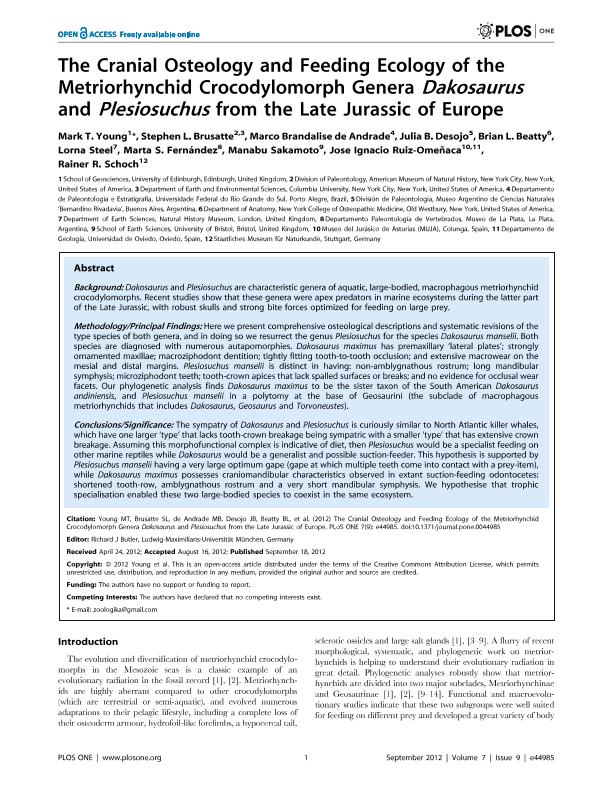Mostrar el registro sencillo del ítem
dc.contributor.author
Young, Mark T.
dc.contributor.author
Brusatte, Stephen L.
dc.contributor.author
Brandalise de Andrade, Marco

dc.contributor.author
Desojo, Julia Brenda

dc.contributor.author
Beatty, Braian L.
dc.contributor.author
Steel, Lorna
dc.contributor.author
Fernández, Marta Susana

dc.contributor.author
Sakamoto, Manabu
dc.contributor.author
Ruiz Omeñaca, José Ignacio

dc.contributor.author
Schoch, Rainer

dc.date.available
2019-05-09T15:58:53Z
dc.date.issued
2012-09
dc.identifier.citation
Young, Mark T.; Brusatte, Stephen L.; Brandalise de Andrade, Marco; Desojo, Julia Brenda; Beatty, Braian L.; et al.; The Cranial Osteology and Feeding Ecology of the Metriorhynchid Crocodylomorph Genera Dakosaurus and Plesiosuchus from the Late Jurassic of Europe; Public Library of Science; Plos One; 7; 9; 9-2012; 1-42
dc.identifier.issn
1932-6203
dc.identifier.uri
http://hdl.handle.net/11336/75965
dc.description.abstract
Background: Dakosaurus and Plesiosuchus are characteristic genera of aquatic, large-bodied, macrophagous metriorhynchid crocodylomorphs. Recent studies show that these genera were apex predators in marine ecosystems during the latter part of the Late Jurassic, with robust skulls and strong bite forces optimized for feeding on large prey. Methodology/Principal Findings: Here we present comprehensive osteological descriptions and systematic revisions of the type species of both genera, and in doing so we resurrect the genus Plesiosuchus for the species Dakosaurus manselii. Both species are diagnosed with numerous autapomorphies. Dakosaurus maximus has premaxillary 'lateral plates'; strongly ornamented maxillae; macroziphodont dentition; tightly fitting tooth-to-tooth occlusion; and extensive macrowear on the mesial and distal margins. Plesiosuchus manselii is distinct in having: non-amblygnathous rostrum; long mandibular symphysis; microziphodont teeth; tooth-crown apices that lack spalled surfaces or breaks; and no evidence for occlusal wear facets. Our phylogenetic analysis finds Dakosaurus maximus to be the sister taxon of the South American Dakosaurus andiniensis, and Plesiosuchus manselii in a polytomy at the base of Geosaurini (the subclade of macrophagous metriorhynchids that includes Dakosaurus, Geosaurus and Torvoneustes). Conclusions/Significance: The sympatry of Dakosaurus and Plesiosuchus is curiously similar to North Atlantic killer whales, which have one larger 'type' that lacks tooth-crown breakage being sympatric with a smaller 'type' that has extensive crown breakage. Assuming this morphofunctional complex is indicative of diet, then Plesiosuchus would be a specialist feeding on other marine reptiles while Dakosaurus would be a generalist and possible suction-feeder. This hypothesis is supported by Plesiosuchus manselii having a very large optimum gape (gape at which multiple teeth come into contact with a prey-item), while Dakosaurus maximus possesses craniomandibular characteristics observed in extant suction-feeding odontocetes: shortened tooth-row, amblygnathous rostrum and a very short mandibular symphysis. We hypothesise that trophic specialisation enabled these two large-bodied species to coexist in the same ecosystem.
dc.format
application/pdf
dc.language.iso
eng
dc.publisher
Public Library of Science

dc.rights
info:eu-repo/semantics/openAccess
dc.rights.uri
https://creativecommons.org/licenses/by/2.5/ar/
dc.subject
Metriorhynchid Crocodylomorph
dc.subject
Dakosaurus-Plesiosuchus
dc.subject
Late Jurassic
dc.subject
Europe
dc.subject.classification
Meteorología y Ciencias Atmosféricas

dc.subject.classification
Ciencias de la Tierra y relacionadas con el Medio Ambiente

dc.subject.classification
CIENCIAS NATURALES Y EXACTAS

dc.title
The Cranial Osteology and Feeding Ecology of the Metriorhynchid Crocodylomorph Genera Dakosaurus and Plesiosuchus from the Late Jurassic of Europe
dc.type
info:eu-repo/semantics/article
dc.type
info:ar-repo/semantics/artículo
dc.type
info:eu-repo/semantics/publishedVersion
dc.date.updated
2019-04-26T18:26:06Z
dc.journal.volume
7
dc.journal.number
9
dc.journal.pagination
1-42
dc.journal.pais
Estados Unidos

dc.journal.ciudad
San Francisco
dc.description.fil
Fil: Young, Mark T.. University of Edinburgh; Reino Unido
dc.description.fil
Fil: Brusatte, Stephen L.. American Museum of Natural History; Estados Unidos. Columbia University; Estados Unidos
dc.description.fil
Fil: Brandalise de Andrade, Marco. Universidade Federal do Rio Grande do Sul; Brasil
dc.description.fil
Fil: Desojo, Julia Brenda. Consejo Nacional de Investigaciones Científicas y Técnicas. Oficina de Coordinación Administrativa Parque Centenario. Museo Argentino de Ciencias Naturales “Bernardino Rivadavia”; Argentina
dc.description.fil
Fil: Beatty, Braian L.. New York College of Osteopathic Medicine; Estados Unidos
dc.description.fil
Fil: Steel, Lorna. Natural History Museum; Reino Unido
dc.description.fil
Fil: Fernández, Marta Susana. Consejo Nacional de Investigaciones Científicas y Técnicas. Centro Científico Tecnológico Conicet - La Plata; Argentina. Universidad Nacional de La Plata. Facultad de Ciencias Naturales y Museo. División Paleontología Vertebrados; Argentina
dc.description.fil
Fil: Sakamoto, Manabu. University of Bristol; Reino Unido
dc.description.fil
Fil: Ruiz Omeñaca, José Ignacio. Universidad de Oviedo; España
dc.description.fil
Fil: Schoch, Rainer. Staatliches Museum für Naturkunde, Stuttgart; Alemania
dc.journal.title
Plos One

dc.relation.alternativeid
info:eu-repo/semantics/altIdentifier/url/http://www.plosone.org/article/info%3Adoi%2F10.1371%2Fjournal.pone.0044985
dc.relation.alternativeid
info:eu-repo/semantics/altIdentifier/doi/https://doi.org/10.1371/journal.pone.0044985
Archivos asociados
